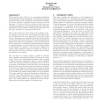Free Online Productivity Tools
i2Speak
i2Symbol
i2OCR
iTex2Img
iWeb2Print
iWeb2Shot
i2Type
iPdf2Split
iPdf2Merge
i2Bopomofo
i2Arabic
i2Style
i2Image
i2PDF
iLatex2Rtf
Sci2ools
IWRIDL
2006
ACM
2006
ACM
Shallow syntax analysis in Sanskrit guided by semantic nets constraints
We present the state of the art of a computational platform for the analysis of classical Sanskrit. The platform comprises modules for phonology, morphology, segmentation and shallow syntax analysis, organized around a structured lexical database. It relies on the Zen toolkit for finite state automata and transducers, which provides data structures and algorithms for the modular construction and execution of finite state machines, in a functional framework. Some of the layers proceed in bottom-up synthesis mode for instance, noun and verb morphological modules generate all inflected forms from stems and roots listed in the lexicon. Morphemes are assembled through internal sandhi, and the inflected forms are stored with morphological tags in dictionaries usable for lemmatizing. These dictionaries are then compiled into transducers, implementing the analysis of external sandhi, the phonological process which merges words together by euphony. This provides a tagging segmenter, which ...
| Added | 14 Jun 2010 |
| Updated | 14 Jun 2010 |
| Type | Conference |
| Year | 2006 |
| Where | IWRIDL |
| Authors | Gérard P. Huet |
Comments (0)

